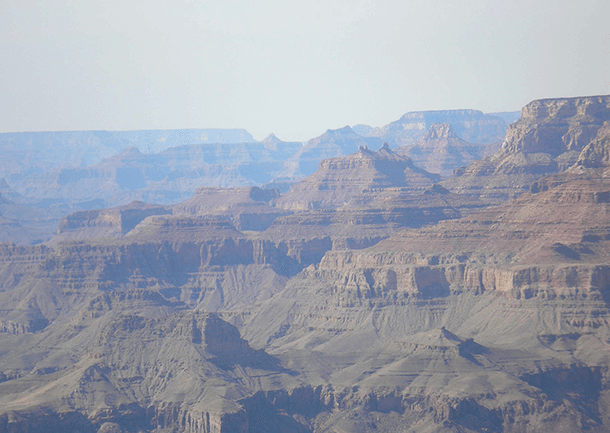Fighting the haze at the Grand Canyon
The Grand Canyon on a hazy autumn day.
Back in 2009, industrial giant Cemex wanted to build a new plant near the Grand Canyon. Opposition forced the company to relocate the project farther away. Nevertheless, the battle to preserve air quality and visibility at the canyon is ongoing.
The view from the rim of the canyon has noticeably improved over the last two decades, thanks to the Clean Air Act, park rangers say. The law forced a power plant that flanked the canyon to install expensive scrubbers; a second nearby plant closed.
“The Clean Air Act of the United States says that no man-made air pollution shall impair visibility at the Grand Canyon National Park and other parks. Zero. We are not to be fouling the air at the Grand Canyon,” says Northern Arizona University environmental engineer Bill Auberle.
The National Park Service keeps records of air quality at the Grand Canyon going back several decades. Some of those measurements continue today, but the actual visibility at the canyon is not one of them, Auberle says.
“Visitors expect to see the splendor of the visibility across the many miles of the canyon, and that's no longer measured in terms of visual range,” Auberle explains. “Gases and microscopic particles at the canyon are measured, so we have indicators of air quality, but we don't have a good measurement of visibility.”
There is persistent haze at the canyon which, unfortunately, affects the experience for some of the nearly five million annual visitors to the site. Some of this is caused by smog from as far away as Los Angeles and some of it is caused by nearby mining.
“We have active uranium mining in the region that's been going on for many, many years. It's an important part of the economy,” Auberle says. "But no new mining is being permitted. There’s a moratorium in place that precludes additional uranium mining until a much broader assessment is done of the environmental threats.”
Right now, a bill is moving through Congress that would encourage the president to establish a new Grand Canyon National Monument encompassing much of the region around the Grand Canyon. Auberle believes the monument designation has a great deal of merit, so long as current uses of the area, such as camping, hiking, hunting and fishing, are allowed to continue under the monument designation.
“These are very important outdoor activities in the region,” Auberle says. “The good thing about the Antiquities Act is that it allows the president to create a national monument [and] gives the president flexibility as to what this continued usage can be.”
Auberle remains “cautiously optimistic” about the future of air quality in the region.
“We are producing and requiring ever-cleaner motor vehicles. We also have secured long-term commitments from industries in the region — copper smelters, coal-fired power plants and other manufacturing activities,” Auberle says. “In coming years, and admittedly, in some cases, a couple of decades, we will see those sources significantly cleaned up or retired, and the Canyon and its air quality will be the beneficiary.”
This article is based on an interview that aired on PRI’s Living on Earth with Steve Curwood.
